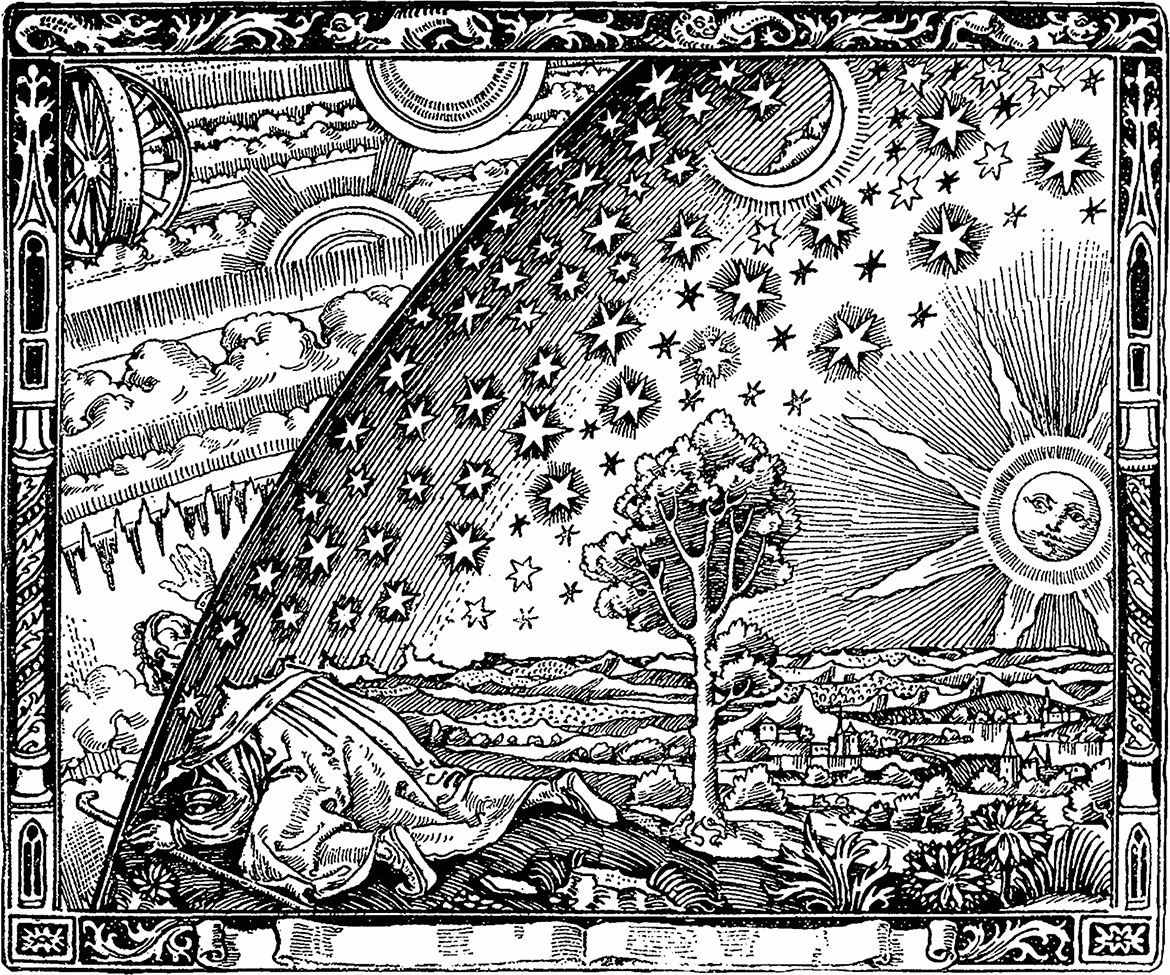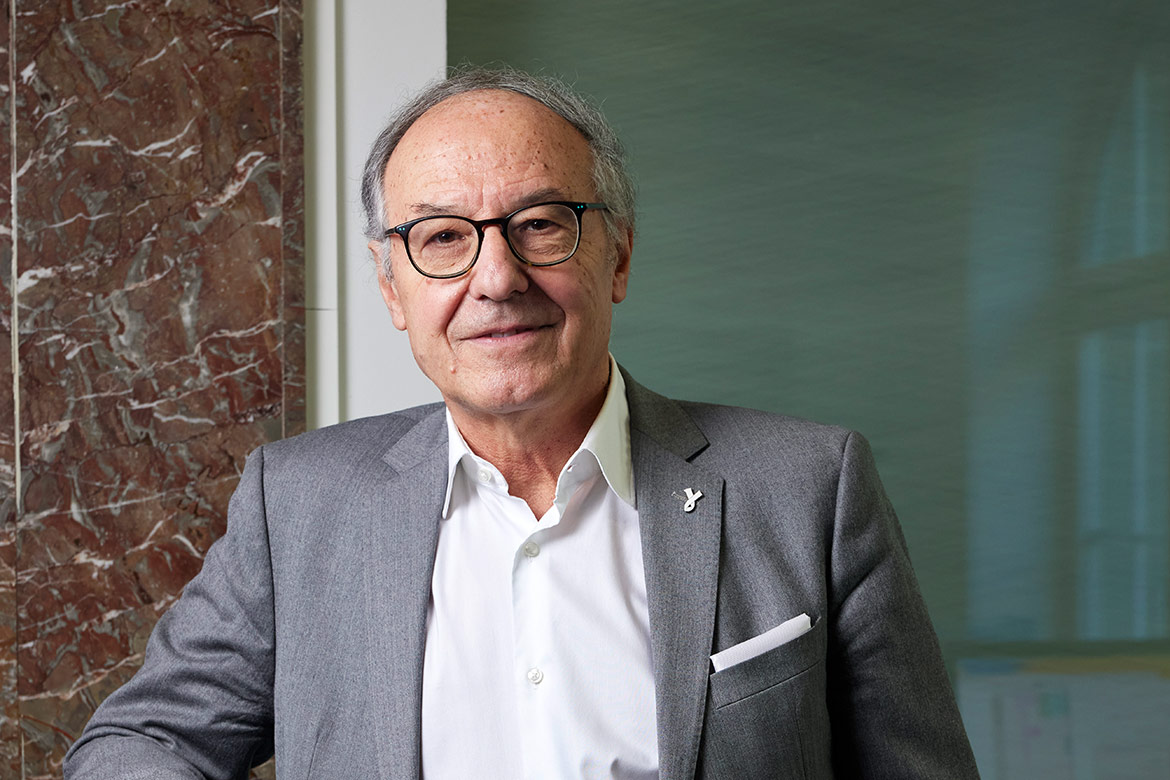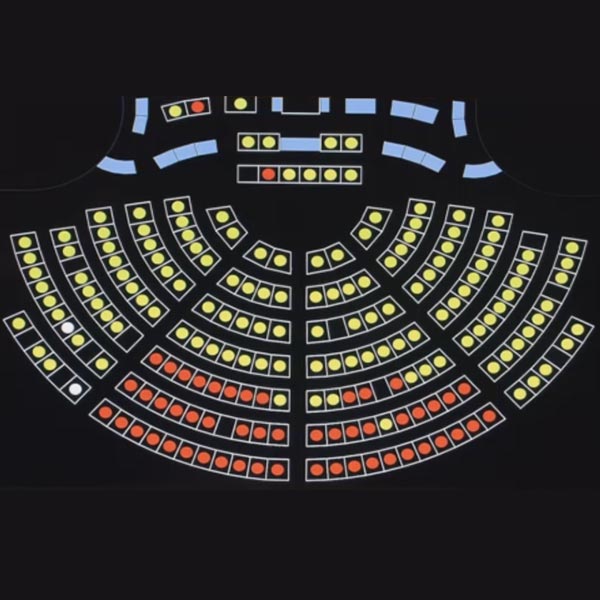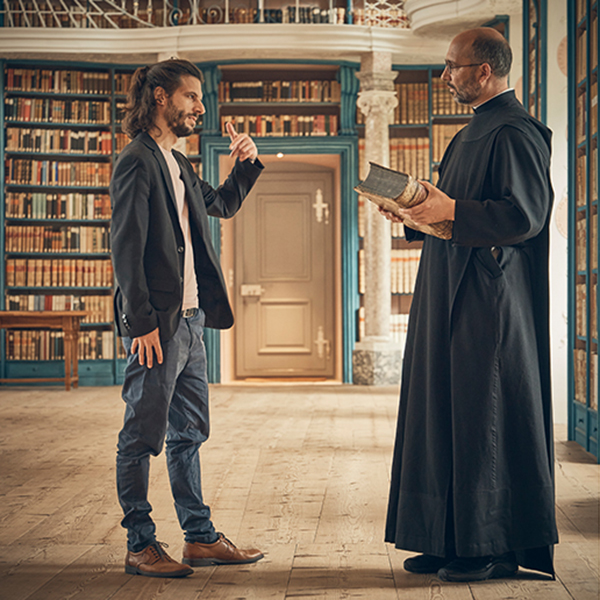Feature: Belief in science
The sea of faith in an ocean of science
Theology is based on faith, obviously. But not even physics and maths are free of it. Just how much do researchers really subject the foundations of their knowledge to critical questioning? We embark on a voyage of discovery through the different disciplines.

In the Middle Ages, people believed you might be able to venture to the edge of heaven and view the mysterious Beyond – and thereby find proof for your beliefs. | Image: Wikimedia
Science confirms or rejects its theories and hypotheses based on observation – from observing experiments, for example. When we conduct our everyday research, the rules of empiricism and reproducibility apply just as they do when we put our results into practice. But things that function within each individual discipline can also become a matter of faith. When viewed from outside, many basic principles, theories and models can be seen to stand on rather rickety foundations.
Horizons has decided to carry out a random sample across the disciplines to find out where faith begins in science. And where it stops. When do we believe things to be true, even when no verifiable reasons support them?
In 1995 the two Swiss Nobel Laureates Dider Queloz and Michel Mayor discovered an exoplanet orbiting the star 51 Pegasi, a finding which turned upside down the prevailing theories about how planets are formed. According to the philosopher Karl Popper, this is precisely how scientific theories should be proven wrong.
But theories in physics can’t always be proven wrong. String theory is a physical model that is intended to reconcile and unite all the fundamental forces that we’ve observed, but it is so speculative – says the physicist Peter Woit – that it cannot even be proven wrong. According to the science journalist John Horgan, “at its best, physics is the most potent and precise of all scientific fields, and yet it surpasses even psychology in its capacity for bullshit”.
The science philosopher Claus Beisbart doesn’t go quite so far, but he does explain how other theories run contrary to string theory, such as loop quantum gravity, and how both cannot be correct. “If someone today believes one of these theories to be true, then it’s not a matter of knowledge, it’s pure belief”. Many researchers, he says, tend to pursue such theories more as a hobby, “but all the same, they still think that their approach deserves more attention than any other. And when asked for their reasons, they tend to say that their theory is especially straightforward. Or that it’s really beautiful”.
If you want to get on in science, says Beisbart, you don’t need faith; you just need to pursue hypotheses. There’s an interesting phenomenon to be observed here: “It’s psychologically difficult to pursue a hypothesis for years while still believing it’s just a hypothesis. There’s the danger that it becomes an article of faith. Investigations have proven that if someone works with the same model over several years, then at some point he’ll start to believe in it. He is no longer able to approach the data from a neutral standpoint, but twists them to fit his model”. Researchers therefore run the risk of becoming believers in their own assumptions.
String theory is an attempt to find a ‘theory of everything’. But doesn’t this smack somehow of religion? Beisbart disagrees. “It’s in the nature of science to link things, to systematise and to seek for unity”. According to the philosopher Immanuel Kant, the urge to unify is a regulatory ideal that cannot always be achieved, but should always be striven for. “It mustn’t be an article of faith, but only a goal”, says Beisbart. He also warns that it is a misunderstanding to speak of religious belief when scientists believe in a speculative theory. Because in religion, you rely on a higher being and organise your life accordingly. This is not at all the case in physics.
Among the European mathematicians of the early modern period there were several who occupied themselves with the connection between believing in a higher being and mathematics itself. For example, the German mathematician Georg Cantor in the 19th century believed that his theory of transfinite numbers offered insights into the divine.
Today, debate focuses on other matters, such as whether the axioms of set theory as established some hundred years ago are consistent or not. Today, they are the basis of almost all mathematics. According to Roy Wagner, a professor of the history and philosophy of mathematical sciences at ETH Zurich, their consistency is not just unproven, but also unprovable according to mathematical standards. All the same, most mathematicians believe in it.
Wagner explains that mathematicians also often have to trust the judgement of experts when it comes to innovative, complex, long proofs. “Only a few people can actually understand them. And sometimes there are differences of opinion”. Mathematicians generally believe that every correct proof can be checked by a computer. “But you have to believe that the corresponding software is functioning properly”.
Despite all this uncertainty, Wagner sees no point in maths or anywhere else in science where belief ends and science begins. “If I offer a scientific argument, I believe that I have made no mistakes, that the knowledge on which I am constructing my argument is well-founded, and that the system I am applying is valid”. He is convinced that “anyone who believes in belief-free knowledge has an unrealistic notion of science”.
Every discipline has to believe in certain key assumptions. But when it comes to their concrete application, belief should not play any role at all. Such as in medicine, for example. Either a therapy works, or it doesn’t – and either it has side-effects, or it doesn’t. Evidence-based medicine only applies a method of treatment when a study has proven it to be effective and safe. But that often isn’t the case in the therapies of complementary medicine.
Yet even here, belief isn’t so easy to separate from knowledge. The number of possible therapy variants and of patient groups in classical medicine is simply too big. Many drugs, for example, are only tested on men, but are then used on women and children. We simply assume that they will have the same effect, though without having proved it. But successful therapies in complementary medicine often have a hard time of it. “In some circumstances it can take a long time for a practice to be integrated as a routine clinical procedure, even when it is proven to be effective”, says Edzard Ernst, a German doctor who is the world’s first-ever professor of complementary medicine.
When Ernst started in his newly created post at the University of Exeter, UK, in 1993, the data situation regarding homeopathy was unclear. So he took it upon himself to create clarity. “We can be pretty certain today that homeopathy works – though only via a placebo effect”, says Ernst. In other words, even a sham treatment that only has the appearance of homeopathy can have the same effect. It’s the patient’s expectations that are decisive. Meanwhile, the universities of Bern, Zurich and Basel have followed Exeter’s example and have also set up professorships in complementary medicine. This is simply in reaction to the increasing demand for complementary medical procedures.
Ernst is in principle happy that there are more professorships in his field. But he takes a critical view of the scientific work being carried out. Often, he says, researchers are simply engaged in doing more surveys and publishing statistical observations. When clinical studies are carried out, usually a standard therapy is complemented (appropriately) by a ‘complementary’ therapy, and then compared to those cases where the standard therapy has been applied on its own. “I have shown repeatedly that such a study can almost never have a negative result”, says Ernst. In other words, the result is usually positive for the complementary treatment – which could simply mean that the researchers are keen to justify what they already believe anyway.
We have approached numerous researchers active in complementary medicine at the universities of Zurich and Bern, but they don’t want to talk to us about aspects of belief within their discipline. This doesn’t surprise Ernst: “It’s rare to find criticism within the discipline of complementary medicine. Criticism is an important step on the path to progress, but this has not yet been fully accepted”.
The branch of academia that has belief as its actual object of study, theology, has a lot of experience in standing up to criticism, even though some of its harshest critics are in its own ranks. The German theologian Heinz-Werner Kubitza, for example, writes in his book “Der Dogmenwahn” (“The dogma mania”) that theology is a curiosity at modern universities. This is because it is not even clear whether its central object of study exists, the ‘theos’. But for Barbara Hallensleben, a theologian at the University of Fribourg and a professor of dogmatic and ecumenical theology, this is in itself a matter to be celebrated. “If something is a curiosity, then it makes us curious, and thus stands at the beginning of a possible discovery”. Even Kubitza’s broadsides against the theos can’t disturb her composure. “If God is an object in a chain of finite objects, then he does not exist. If I talk about God, then I am asking questions about fundamental things and goals”.
Faith belongs to the constitution of theology from the outset. “We live in a cultural part of the world that is highly determined by precisely this faith. It is good if people reflect on it, also in order to understand where we come from. Theology doesn’t always just mean staring at the heavens, but investigating the traces of this faith and this God in history”. Faith also results in disturbance of thought; it never ceases to raise questions, nor ceases trying to understand.
Today, theology is an extraordinarily differentiated, method-conscious discipline, says Hallensleben. “Strictly speaking, science is the methodologically led search for an accountable answer to a precise question. Even someone who does not share a faith can comprehend why one might reach a specific result on this basis”. In her everyday work, Hallensleben’s theology is based on numerous scientific methods. “I decipher manuscripts, interpret texts, analyse arguments. In these things, we need all the methodological precision of science”.
Returning to Kubitza, we see that another reason for him finding theology a curiosity at university is the confessional differences that exist – there is a Reformed theology, and a Catholic theology. But Hallensleben doesn’t agree. “Every scientific discipline has its squabbles that are sometimes pursued as if they were religious wars”. Her experience of the different denominations is even more pluralistic, since she also works with evangelical and Orthodox students. The plurality of Christian denominations is a clear sign of the incompleteness of theology. “It interprets the truths of faith not within a fixed system, but continually approaches things from different sides. It’s a kind of struggle, but in a positive sense. Science is also always a struggle to find answers”.




